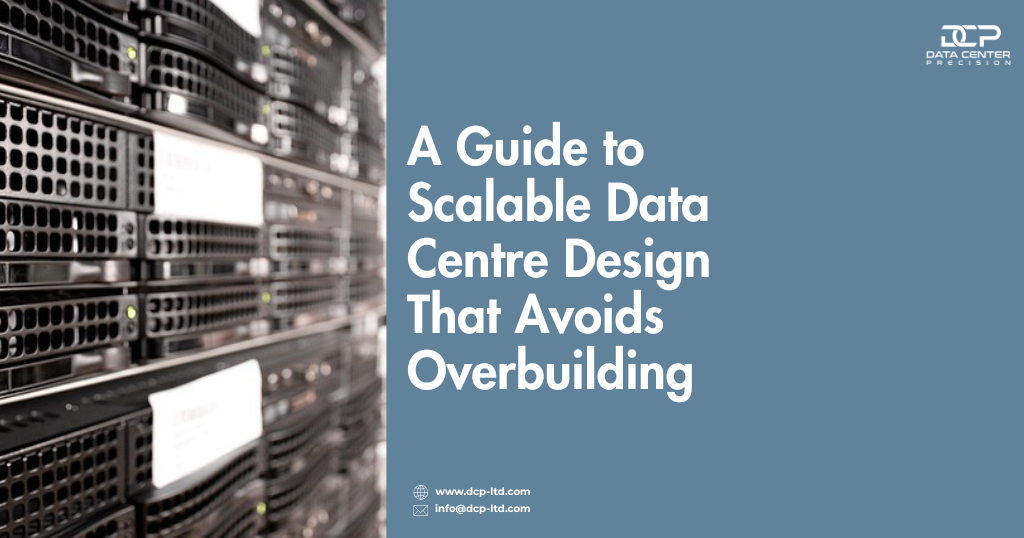Insights

A Guide to Scalable Data Centre Design That Avoids Overbuilding
Planning a data centre requires more than meeting current demand. Building too far ahead leads to waste. Waiting too long causes disruption. The key is a design that grows when needed, without doing too much too soon.
This guide answers five practical questions to help you design with clarity and avoid overbuilding.
What Is Scalability in Data Centres?
Scalability means the data centre can grow or adapt without a complete redesign. It involves preparing for increased demand in a controlled and cost-effective manner.
You might start with fewer racks, lower power draw, or lighter cooling loads, but with plans to expand in the future. For example, you could install conduits and power panels during Phase 1, then add hardware as business needs increase.
Scaling isn’t limited to physical space. It also involves systems that can handle more connections, more data, and more users as demand grows.
How Would You Design a Scalable and Redundant Data Centre Network?
Start by thinking ahead about how much your needs will grow in two, five, or ten years. Base your design on real projections, not guesswork.
Utilise modular systems that enable expansion without interrupting live operations. Keep power, cooling, and connectivity designed for phased upgrades. Leave capacity in your cable trays, space in your rooms, and extra ports in your switches.
Redundancy means your network continues to operate even if one component fails. That means dual paths for power and data, independent cooling loops, and mirrored systems. Each core service should have a backup that can take over without delay.
One way to achieve this is to design zones with separate inputs and failover logic. If zone A loses its link, zone B steps in. This avoids downtime and prevents data loss.
Planning your data centre build or upgrade? We help businesses design infrastructure that grows in controlled stages—without overcommitting on day one.
What Are the Criteria for Data Centre Design?
A thriving data centre supports growth, reliability, and security from day one. Key design criteria include:
Location
Select a location with stable power, multiple network providers, and minimal physical risk. Think about access for equipment deliveries and long-term expansion.
Power and Cooling
Plan for current needs and future additions. Cooling should match heat output, and power distribution should allow for load balancing and upgrades.
Space Planning
Keep layouts flexible. Use hot and cold aisle containment if needed. Leave enough space to add racks, cables, or ducts without moving the existing kit.
Connectivity
Build with capacity and routing in mind. Connect to more than one carrier and plan cable runs that avoid congestion or signal loss.
Security
Limit physical access with locks, cameras, and monitored entry. Keep visitor and staff areas separate from operational zones.
Meeting these criteria helps you build a facility that performs well now and can support growth later without structural change.
Need support balancing capacity with future growth? Our team works with you to define clear requirements and develop phased designs tailored to your business needs.
What Are the Three Main Components of Scalability?
Scalable design depends on three linked areas:
1. Physical Layout
Leave room to expand your footprint, whether by adding racks, air handlers, or switchboards. Layouts should enable the installation of new equipment without downtime.
2. Utility Support
Built in spare power and cooling capacity. Your systems should allow you to add loads in controlled stages without overloading.
3. Network Growth
Use switches, fibre paths, and protocols that support added connections without needing replacements. This keeps upgrades simple and avoids bottlenecks.
These three areas must work together. Planning one without the other can limit your options when expansion becomes necessary.
What Are the Five Core Elements of Data Centre Infrastructure?
All data centres depend on five primary elements. Getting each one right supports performance, security, and expansion.
1. Space
Includes all physical areas, such as server halls, access points, cable routes, and service rooms. Design for flow, not just for fit.
2. Power
From grid feeds to generators, your power design must support the load and offer backup paths. Include room for future capacity increases.
3. Cooling
Your cooling strategy should match your hardware’s output and adapt to new equipment as needed. Use zoned systems that scale with demand.
4. Connectivity
Support internal and external data flow with structured cabling, diverse routes, and carrier choice. Build with both redundancy and performance in mind.
5. Monitoring and Security
Track temperature, power use, air quality, and network activity. Use this data to decide when and where to grow. A real-world example: one UK-based enterprise built its first 100-rack room but left 50% of it unpopulated. They monitored usage patterns, installed sensors in each rack, and expanded in planned blocks as workloads increased. This helped them control costs and avoid unnecessary overbuilds.
Interested in working together?
Designing a data centre that supports long-term growth without overbuilding takes planning, technical insight, and experience. At DCP Ltd, we work with organisations across sectors to deliver infrastructure that meets current needs and adapts when demand increases without wasting space, power, or capital.
Whether you're building your first facility, upgrading an existing one, or looking to introduce redundancy and modular expansion, we can support your team through every stage of the process.
From design and layout to power planning and capacity forecasting, we bring precision to every decision.
Ready to build smarter? Let's start the conversation.

2 Comments
David Shon
Nam vel lacus eu nisl bibendum accumsan vitae vitae nibh. Nam nec eros id magna hendrerit sagittis. Nullam sed mi non odio feugiat volutpat sit amet nec elit.
Jhon Watchson
Nam vel lacus eu nisl bibendum accumsan vitae vitae nibh. Nam nec eros id magna hendrerit sagittis. Nullam sed mi non odio feugiat volutpat sit amet nec elit.